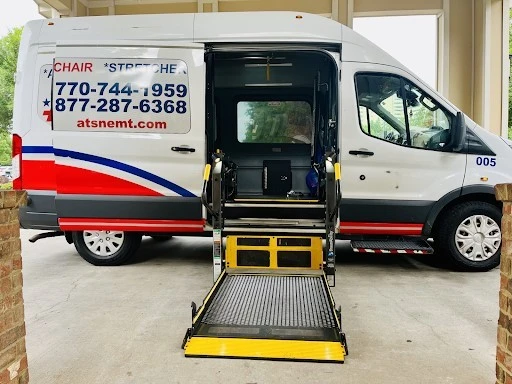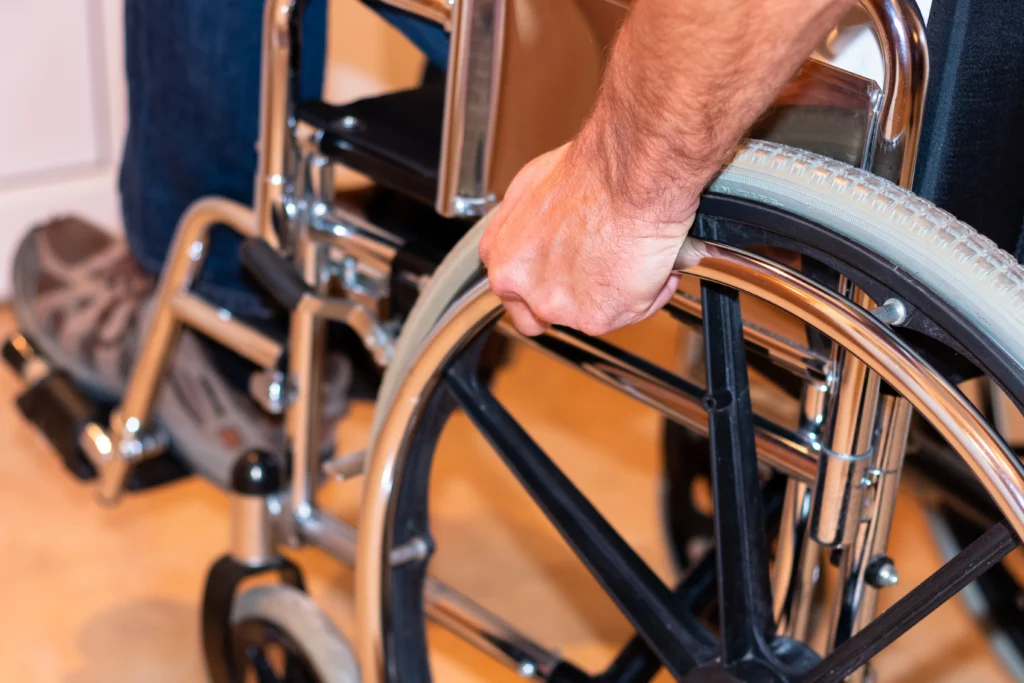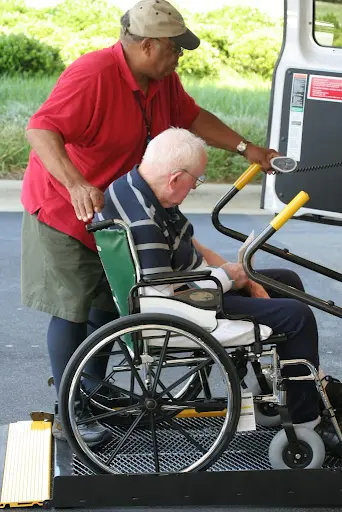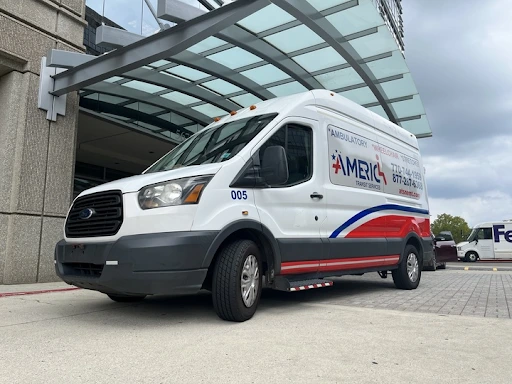The Vital Role of Wheelchair Accessible Transport: Ensuring Inclusivity and Mobility Services

In an evolving world where the need for inclusivity can no longer be ignored, discussion about wheelchair accessible transport takes the lead. Imagine being unable to accomplish basic daily tasks due to inadequate transportation facilities. For millions of people worldwide, this is not just a hypothetical situation but a hard-hitting reality. This blog post will take you on a journey into the critical role wheelchair accessible transport plays in society, ensuring everyone—from our loved ones to strangers—has equal access to mobility services. Prepare to delve deep into understanding why it’s not just a matter of convenience, but an essential pillar for upholding human rights and dignity for all citizens.
The Vital Role of Wheelchair Accessible Transport is to provide safe, reliable, and accessible transportation options for individuals with mobility impairments. It plays a crucial role in improving the quality of life for wheelchair users by enabling them to maintain independence, access necessary services, attend appointments, and participate in social activities. Accessible transportation helps ensure that everyone can fully participate in society and achieve their goals regardless of physical abilities.
Defining Wheelchair Accessible Transport
Wheelchair Accessible Transport (WAT) plays a vital role in ensuring mobility, independence, and access to necessary services for individuals who use wheelchairs. It serves as a lifeline for disabled individuals by providing specialized transportation options catered to their unique needs. WAT helps bridge the gap between their physical limitations and the ability to comfortably and safely navigate their surroundings.
Imagine being a wheelchair user with an important medical appointment or attending a social event. Without WAT, these basic activities become challenging and often impossible.
WAT involves transportation services that are specifically designed and equipped to accommodate wheelchair users. These services prioritize accessibility, ensuring that wheelchair users can easily enter, exit, and travel comfortably in vehicles. They provide features such as ramps or lifts, securement systems to keep the wheelchair in place during transit, and ample space for maneuvering within the vehicle.
Let’s say Sarah is a student who uses a wheelchair due to a spinal cord injury. She relies on WAT to attend classes in her university. The transport service she chooses provides a ramp to facilitate easy entry into the vehicle, securement straps to keep her wheelchair stable during the journey, and enough space inside the vehicle for her to move around comfortably. This ensures that Sarah can maintain an active and engaged lifestyle without limitations.
Now that we understand what WAT entails, let’s explore the different types of wheelchair transport services available to disabled individuals.
Wheelchair accessible transport may use specially modified vans or buses with ramps or lifts to facilitate easy entry and exit for individuals using wheelchairs. Some taxis and rideshare services also offer wheelchair accessible vehicles.
Types of Wheelchair Transport Services
There are various types of wheelchair transport services tailored to meet the diverse needs of disabled individuals:
- Accessible Public Transportation: Many cities offer accessible public transportation options such as buses or trains with features like ramps, lifts, designated seating areas for wheelchair users, and audible announcements. These services aim to provide equal access for all passengers.
- Private Wheelchair Transport Companies: Private companies specialize in providing door-to-door transportation services for wheelchair users. These services offer convenience and flexibility, allowing individuals to schedule rides according to their specific needs. Private wheelchair transport companies often have trained drivers who can assist passengers during the journey.
- Non-Emergency Medical Transportation: This type of service is designed specifically for transporting individuals with disabilities or medical conditions to and from medical appointments, therapy sessions, or healthcare facilities. Non-emergency medical transportation providers ensure that a person’s medical needs are met during transit, offering trained staff and specialized vehicles equipped with necessary medical equipment.
- Accessible Taxi Services: Some cities have accessible taxi services that provide wheelchair-accessible vehicles for on-demand transportation. These services cater to individuals who need immediate and spontaneous travel arrangements.
- Ride-Sharing Services: Certain ride-sharing platforms now offer options for wheelchair-accessible vehicles (WAVs). This innovation provides wheelchair users with additional transportation choices and the convenience of booking rides through mobile applications.
For instance, John, a wheelchair user living in a city with accessible public transportation, mainly relies on buses to get around. He appreciates the ramps that allow him to board the bus easily and securement systems that keep his wheelchair in place during the journey. However, if John needs to travel to a medical appointment or attend social events outside the regular bus routes, he may opt for a private wheelchair transport company that offers more customizable services.
Just as there are different modes of transportation available for able-bodied individuals to suit their various needs, the same principle applies to wheelchair users. The availability of diverse types of wheelchair transport services ensures that disabled individuals have options tailored specifically to their mobility requirements.
Understanding the impact of WAT on urban mobility is essential to grasp its significance not only for individuals with disabilities but also for creating inclusive communities and cities.

The Impact of WAT on Urban Mobility
Urban mobility is a critical aspect of modern city life, and wheelchair accessible transport (WAT) plays a vital role in ensuring inclusivity and mobility services for disabled individuals. The impact of WAT on urban mobility is far-reaching, positively influencing the lives of countless individuals with disabilities by providing them with reliable transportation options.
One significant impact of WAT on urban mobility is the increased accessibility it offers to disabled individuals. Accessible public transportation options, such as buses and trains equipped with ramps and lifts, enable wheelchair users to navigate the city more independently. By providing accessible routes and vehicles, WAT makes it possible for individuals with disabilities to access essential services like medical appointments, education, employment opportunities, and social gatherings.
Take the example of Sarah, a university student who uses a wheelchair due to a spinal cord injury. Without access to wheelchair accessible buses or trains, Sarah would face immense challenges in attending classes or participating in campus activities. However, with the availability of WAT options like accessible buses or paratransit services, Sarah can travel effortlessly around the city, fostering her independence and enriching her academic experience.
Additionally, WAT promotes social inclusion by allowing disabled individuals to actively engage in their communities. When people have convenient ways to reach public spaces, parks, shopping centers, restaurants, and other recreational venues, they can participate fully in social interactions and enjoy cultural experiences. This fosters a sense of belonging and combats isolation that often accompanies physical limitations.
Moreover, the impact of WAT extends beyond individual benefits. By providing accessible transport options to disabled individuals, cities embrace diversity and promote equality. Inclusive urban environments enhance the overall quality of life for all residents by creating an atmosphere where everyone can move freely and access essential services without barriers. This can contribute to building stronger communities that value diversity and prioritize the needs of every citizen.
Having explored the positive impact of WAT on urban mobility, let’s now delve into how it enables access and movement for disabled persons.
Enabling Access and Movement for Disabled Persons
WAT plays a crucial role in enabling access and movement for disabled persons, empowering them to overcome physical limitations and participate fully in society. It ensures that individuals using wheelchairs have safe and reliable transportation options that address their unique needs.
One key aspect of WAT is the provision of specially equipped vehicles that accommodate wheelchair users. Accessible features such as ramps, lifts, spacious interiors, securement systems, and proper harnesses ensure a safe and comfortable journey for disabled individuals. These modifications allow wheelchair users to board and alight from vehicles independently or with minimal assistance, enhancing their sense of dignity and autonomy.
Consider John, a wheelchair user who relies on a motorized wheelchair for mobility due to muscular dystrophy. With the availability of WAT services that offer specially equipped vans with easy-to-use ramps and securement systems, John can easily board the vehicle without requiring assistance from others. This freedom to travel independently instills a sense of empowerment and boosts his confidence to remain active both socially and professionally.
Furthermore, WAT provides trained drivers who are knowledgeable about assisting individuals with disabilities. These drivers undergo specialized training to ensure they can operate the equipment safely, provide appropriate support when needed, and offer a respectful and inclusive experience for passengers. The presence of trained drivers not only ensures the physical well-being of wheelchair users during their journeys but also contributes to their overall comfort and peace of mind.
Wheelchair accessible transport goes beyond physical mobility; it empowers disabled individuals to live fuller lives by facilitating access to various essential services, medical appointments, therapy sessions, social events, and recreational activities. However, there are still challenges to be addressed in achieving comprehensive accessibility in urban environments.

Safety Standards in WAT
Ensuring the safety of passengers is a paramount concern when it comes to wheelchair accessible transport (WAT). Adhering to rigorous safety standards not only protects the well-being of individuals with accessibility needs but also provides peace of mind for their loved ones. Let’s dive into some key aspects of safety standards in WAT.
First and foremost, when it comes to the vehicles used for WAT, they must meet specific criteria to ensure passenger safety. These criteria often include features such as wheelchair ramps or lifts, secure tie-down systems to keep wheelchairs in place during transit, and adequate space for maneuvering wheelchairs within the vehicle. By implementing these features, transportation providers can minimize the risk of accidents, injuries, or damage to mobility equipment during transport.
Additionally, proper maintenance protocols play a vital role in upholding safety standards. Regular inspections and servicing of vehicles are essential to identify any potential issues before they escalate. This proactive approach helps prevent mechanical failures or malfunctions that could compromise passenger safety.
Furthermore, stringent training requirements are crucial for drivers who operate wheelchair accessible vehicles. It is imperative that drivers undergo specialized training to understand how to properly secure wheelchairs and ensure passenger comfort and safety throughout the journey. They should also receive training on disability awareness and interacting with passengers with respect and empathy.
For instance, drivers may learn techniques on assisting passengers when boarding and disembarking from the vehicle while maintaining their dignity and independence. They may also be trained on how to handle emergency situations effectively and provide basic first aid if needed.
Trained Drivers and Specialized Vehicles
In the realm of wheelchair accessible transport (WAT), trained drivers and specialized vehicles go hand in hand in creating a smooth and comfortable experience for passengers with accessibility needs. Let’s explore the significance of each aspect in more detail.
Trained drivers are essential to guaranteeing a safe and inclusive transportation service. These drivers receive comprehensive training that covers various aspects, including handling specialized equipment, understanding the needs of passengers with disabilities, and maintaining a respectful and accommodating attitude. By having competent and empathetic drivers, passengers can feel reassured that their journey will be handled with care.
Consider a scenario where a driver encounters a passenger who requires assistance beyond the scope of driving. A well-trained driver would be equipped with the knowledge and skills necessary to provide appropriate assistance in a considerate manner, ensuring the passenger feels supported throughout the entire journey.
In addition to trained drivers, specialized vehicles specifically designed for wheelchair accessibility play a crucial role in providing an inclusive transport service. These vehicles are equipped with features such as ramps or lifts that allow easy boarding and disembarking for wheelchair users. They also provide ample space and secure tie-down systems to ensure the safety and stability of wheelchairs during transit.
Just as a tailor-made suit provides comfort and a perfect fit, these specialized vehicles cater to the unique needs of passengers using mobility aids, enhancing their overall travel experience.
By combining well-trained drivers with specialized vehicles, WAT services can offer individuals with accessibility needs greater independence, mobility, and peace of mind. It ensures that they have reliable transportation options available that prioritize their safety and comfort throughout their journeys.
The Future and Regulation of WAT
In a world that strives for inclusivity and equal opportunities, the future of wheelchair accessible transport (WAT) plays a vital role. Governments and regulatory bodies understand the importance of ensuring accessible transportation for all individuals, regardless of their mobility challenges. As a result, there has been an increased focus on the regulation and development of WAT to meet the growing needs of those who rely on them.
One significant aspect of the future of WAT is the ongoing efforts to enhance accessibility in public transportation systems. Many countries have implemented regulations that require public transport providers to have a certain percentage of their fleet designated as wheelchair accessible vehicles (WAVs). These regulations not only guarantee accessibility but also promote equal rights and opportunities for people with disabilities.
Furthermore, government initiatives and incentives are being deployed to encourage the purchase and use of wheelchair accessible vehicles in private transportation as well. Financial assistance programs, tax benefits, and subsidies are often offered to individuals or organizations looking to acquire WATs, making them more affordable and widespread.
For instance, in some countries, there are grants available to help fund the conversion of regular vehicles into wheelchair accessible ones, providing greater flexibility for those who require modified vehicles for their specific needs.
To regulate the industry effectively, governments collaborate closely with manufacturers and service providers. The aim is to establish comprehensive guidelines that ensure both safety standards and usability advancements in WATs. Regular inspections and certifications strive to maintain quality control throughout the manufacturing process and during vehicle operations.
Now let’s turn our attention to another crucial aspect that will shape the future of WAT: technological progress and legal frameworks.
Technological Progress and Legal Frameworks
Over recent years, technological advancements have revolutionized the field of WAT. Manufacturers have embraced innovative solutions to make vehicles more accessible, user-friendly, and comfortable for wheelchair users. The development of wheelchair accessible vehicles (WAVs) has paved the way for independent mobility and improved transportation options.
Moreover, legal frameworks have a significant role in guiding technological progress in WAT. Regulations exist to ensure that the incorporation of technology adheres to safety standards and guarantees an enhanced experience for wheelchair users. This includes features such as ramps or lifts, securement systems to safely immobilize wheelchairs, spacious interiors, and advanced navigation systems catered towards accessibility.
The integration of technology into WAT also extends beyond the vehicles themselves. Digital platforms and mobile applications are being developed to improve accessibility and streamline the booking process for accessible transport services. Real-time tracking systems allow individuals to monitor the arrival time of accessible vehicles, enhancing convenience and reliability.
For example, some cities have implemented apps that provide real-time information on the availability and location of wheelchair accessible taxis. Users can easily request a ride through these platforms, minimizing wait times and ensuring prompt service.
However, as we embrace technology in WAT, it is essential to address concerns regarding data privacy and cybersecurity. Striking a balance between convenience and security is crucial to mitigate any potential risks associated with digital advancements in this area.

Empowering Mobility and Comfort: Exceptional Wheelchair Accessible Transport Americ Transit Services
When it comes to reliable and compassionate wheelchair accessible transport, look no further than Americ Transit Services! We are your dedicated partner, committed to ensuring that individuals with mobility challenges can access transportation services that prioritize their comfort, safety, and well-being.
At Americ Transit Services, we understand the unique needs of individuals who depend on wheelchairs for mobility. That’s why we have gone above and beyond to provide a comprehensive range of wheelchair accessible transport services that cater to various requirements. Whether you’re seeking local transportation for a medical appointment, airport transfers, or long-distance journeys, we have the expertise and resources to make it happen seamlessly.
Our wheelchair accessible vehicles are designed to meet the highest safety and accessibility standards. We take pride in our fleet’s meticulous maintenance, ensuring that each ride is not just comfortable but also secure. Rest assured that when you choose Americ Transit Services, you’re choosing a partner that prioritizes your loved one’s safety above all else.
One of the key strengths of our wheelchair accessible transport service is our compassionate and highly trained staff. Our team members are not only experts in providing safe and efficient transportation but also empathetic individuals who understand the importance of dignity and respect. We treat each passenger like family, ensuring that their journey is not just physically accessible but emotionally supportive as well.
At Americ Transit Services, we believe that accessibility should never come at the cost of convenience. That’s why we offer flexible scheduling options to accommodate your specific needs. We understand that medical appointments, family gatherings, and other commitments can be time-sensitive, and we’re here to ensure that you get there on time, every time.
Our commitment to excellence doesn’t stop at the vehicle or the driver. It extends to our round-the-clock customer support team, ready to assist you with any inquiries or special requests. We understand that life’s unexpected situations can arise, and we’re here to provide the solutions and support you need, 24/7.
Choosing Americ Transit Services for wheelchair accessible transport means choosing reliability, comfort, and peace of mind. We take great pride in being your trusted partner for all your transportation needs, ensuring that everyone has access to safe and inclusive mobility solutions. Let us be the bridge that connects you to the world, one accessible journey at a time.
Don’t settle for anything less than the best when it comes to wheelchair accessible transport. Experience the difference with Americ Transit Services, Book a Ride now and witness how our commitment to safety, compassion, and reliability can transform your transportation experience. Contact us today to learn more about our services and discover why we are the preferred choice for wheelchair accessible transport you can rely on. Your loved one’s mobility is our mission, and we’re here to serve you with utmost care and dedication.
Recent Comments